Make a Manhattan plot
create.manhattanplot.RdTakes a data.frame and creates a Manhattan plot
Usage
create.manhattanplot(
formula,
data,
filename = NULL,
main = NULL,
main.just = 'center',
main.x = 0.5,
main.y = 0.5,
main.cex = 3,
xlab.label = tail(sub('~', '', formula[-2]), 1),
ylab.label = tail(sub('~', '', formula[-3]), 1),
xlab.cex = 2,
ylab.cex = 2,
xlab.col = 'black',
ylab.col = 'black',
xlab.top.label = NULL,
xlab.top.cex = 2,
xlab.top.col = 'black',
xlab.top.just = 'center',
xlab.top.x = 0.5,
xlab.top.y = 0,
xlimits = NULL,
ylimits = NULL,
xat = TRUE,
yat = TRUE,
xaxis.lab = NA,
yaxis.lab = NA,
xaxis.log = FALSE,
yaxis.log = FALSE,
xaxis.cex = 1.5,
yaxis.cex = 1.5,
xaxis.rot = 0,
yaxis.rot = 0,
xaxis.fontface = 'plain',
yaxis.fontface = 'plain',
xaxis.col = 'black',
yaxis.col = 'black',
xaxis.tck = 0,
yaxis.tck = c(1,1),
horizontal = FALSE,
type = 'p',
cex = 2,
pch = '.',
col = 'black',
lwd = 1,
lty = 1,
alpha = 1,
strip.col = 'white',
strip.cex = 1,
axes.lwd = 1,
axes.lty = 'dashed',
key = list(text = list(lab = c(''))),
legend = NULL,
layout = NULL,
as.table = FALSE,
x.spacing = 0,
y.spacing = 0,
x.relation = 'same',
y.relation = 'same',
top.padding = 0,
bottom.padding = 0,
right.padding = 0,
left.padding = 0,
key.top = 0,
key.left.padding = 0,
ylab.axis.padding = 1,
axis.key.padding = 1,
abline.h = NULL,
abline.col = 'black',
abline.lwd = 1,
abline.lty = 1,
add.rectangle = FALSE,
xleft.rectangle = NULL,
ybottom.rectangle = NULL,
xright.rectangle = NULL,
ytop.rectangle = NULL,
col.rectangle = 'transparent',
alpha.rectangle = 1,
add.points = FALSE,
points.x = NULL,
points.y = NULL,
points.pch = 19,
points.col = 'black',
points.cex = 1,
add.text = FALSE,
text.labels = NULL,
text.x = NULL,
text.y = NULL,
text.col = 'black',
text.cex = 1,
text.fontface = 'bold',
height = 6,
width = 10,
size.units = 'in',
resolution = 1600,
enable.warnings = FALSE,
style = 'BoutrosLab',
description = 'Created with BoutrosLab.plotting.general',
preload.default = 'custom',
use.legacy.settings = FALSE,
inside.legend.auto = FALSE,
...
);Arguments
- formula
The formula used to extract the x & y components from the data-frame. Transforming data within formula is not compatible with automatic scaling with `xat` or `yat`.
- data
The data-frame to plot
- filename
Filename for tiff output, or if NULL returns the trellis object itself
- main
The main title for the plot (space is reclaimed if NULL)
- main.just
The justification of the main title for the plot, default is centered
- main.x
The x location of the main title, deault is 0.5
- main.y
The y location of the main title, default is 0.5
- main.cex
Size of text for main plot title
- xlab.label
x-axis label
- ylab.label
y-axis label
- xlab.cex
Size of x-axis label, defaults to 2
- ylab.cex
Size of y-axis label, defaults to 2
- xlab.col
Colour of the x-axis label, defaults to “black”
- ylab.col
Colour of the y-axis label, defaults to “black”
- xlab.top.label
The label for the top x-axis
- xlab.top.cex
Size of top x-axis label
- xlab.top.col
Colour of the top x-axis label
- xlab.top.just
Justification of the top x-axis label, defaults to centered
- xlab.top.x
The x location of the top x-axis label
- xlab.top.y
The y location of the top y-axis label
- xlimits
Two-element vector giving the x-axis limits, defaults to automatic
- ylimits
Two-element vector giving the y-axis limits, defaults to automatic
- xat
Accepts a vector listing where x-axis ticks should be drawn or if automatic scaling is desired, one of three strings: “auto”, “auto.linear” or “auto.log”. Automatic scaling fixes x-axis tick locations, labels, and data values dependent given data. “auto” will determine whether linear or logarithmic scaling fits the given data best, “auto.linear” or “auto.log” will force data to be scaled linearly or logarithmically respectively. Defaults to lattice automatic (TRUE). For more details see `auto.axis()`.
- yat
Accepts a vector listing where y-axis ticks should be drawn or if automatic scaling is desired, one of three strings: “auto”, “auto.linear” or “auto.log”. Automatic scaling fixes y-axis tick locations, labels, and data values dependent given data. “auto” will determine whether linear or logarithmic scaling fits the given data best, “auto.linear” or “auto.log” will force data to be scaled linearly or logarithmically respectively. Defaults to lattice automatic (TRUE). For more details see `auto.axis()`.
- xaxis.lab
Vector listing x-axis tick labels, defaults to automatic (TRUE). Using automatic scaling with xat will overwrite user input. Set to NULL to remove x-axis labels.
- yaxis.lab
Vector listing y-axis tick labels, defaults to automatic (TRUE). Using automatic scaling with yat will overwrite user input. Set to NULL to remove y-axis labels.
- xaxis.log
Logical indicating whether x-variable should be in logarithmic scale (and what base if numeric)
- yaxis.log
Logical indicating whether y-variable should be in logarithmic scale (and what base if numeric)
- xaxis.cex
Size of x-axis scales, defaults to 1
- yaxis.cex
Size of y-axis scales, defaults to 1
- xaxis.rot
Counterclockwise rotation of text in x-axis scales in degrees, defaults to 0
- yaxis.rot
Counterclockwise rotation of text in y-axis scales in degrees, defaults to 0
- xaxis.fontface
Fontface for the x-axis scales
- yaxis.fontface
Fontface for the y-axis scales
- xaxis.col
Colour of the x-axis tick labels, defaults to “black”
- yaxis.col
Colour of the y-axis tick labels, defaults to “black”
- xaxis.tck
Specifies the length of the tick mark, defaults to 1 for both top and bottom axes
- yaxis.tck
Specifies the length of the tick mark, defaults to 1 for both top and bottom axes
- horizontal
xyplot-specific function that allows you to change if type='h' draws lines to the vertical or horizontal axis
- type
Plot type
- cex
Character expansion for plotting symbol
- pch
Plotting character
- col
Point/line colour
- lwd
Specifies line width, defaults to 1
- lty
Specifies line style, defaults to 1 (solid)
- alpha
Specifies line transparency, defaults to 1 (opaque)
- strip.col
Strip background colour, defaults to “white”
- strip.cex
Strip title character expansion
- axes.lwd
Thickness of width of axis lines
- axes.lty
Specifies axis line style, defaults to “dashed”
- key
A list giving the key (legend). The default suppresses drawing
- legend
Add a legend to the plot. Helpful for adding multiple keys and adding keys to the margins of the plot. See xyplot.
- layout
A vector specifying the number of columns, rows (e.g., c(2,1). Default is NULL; see lattice::xyplot for more details
- as.table
Specifies panel drawing order, default is FALSE which draws panels from bottom left corner, moving right then up. Set to TRUE to draw from top left corner, moving right then down
F
- x.spacing
A number specifying the distance between panels along the x-axis, defaults to 0
- y.spacing
A number specifying the distance between panels along the y-axis, defaults to 0
- x.relation
Allows x-axis scales to vary if set to “free”, defaults to “same”
- y.relation
Allows y-axis scales to vary if set to “free”, defaults to “same”
- top.padding
A number specifying the distance to the top margin, defaults to 0
- bottom.padding
A number specifying the distance to the bottom margin, defaults to 0
- right.padding
A number specifying the distance to the right margin, defaults to 0
- left.padding
A number specifying the distance to the left margin, defaults to 0
- key.top
A number specifying the distance at top of key, defaults to 0
- key.left.padding
Amount of padding to go onto any legend on the left
- ylab.axis.padding
A number specifying the distance of label to the y-axis, defaults to 1
- axis.key.padding
A number specifying the distance from the y-axis to the key, defaults to 1
- abline.h
Allow horizontal line to be drawn, default to NULL
- abline.col
Horizontal line colour, defaults to black
- abline.lwd
Specifies horizontal line width, defaults to 1
- abline.lty
Specifies horizontal line style, defaults to 1 (solid)
- add.rectangle
Allow a rectangle to be drawn, default is FALSE
- xleft.rectangle
Specifies the left x coordinate of the rectangle to be drawn
- ybottom.rectangle
Specifies the bottom y coordinate of the rectangle to be drawn
- xright.rectangle
Specifies the right x coordinate of the rectangle to be drawn
- ytop.rectangle
Specifies the top y coordinate of the rectangle to be drawn
- col.rectangle
Specifies the colour to fill the rectangle's area
- alpha.rectangle
Specifies the colour bias of the rectangle to be drawn
- add.points
Allow additional points to be drawn, default is FALSE
- points.x
The x co-ordinates where additional points should be drawn
- points.y
The y co-ordinates where additional points should be drawn
- points.pch
The plotting character for additional points
- points.col
The colour of additional points
- points.cex
The size of additional points
- add.text
Allow additional text to be drawn, default is FALSE
- text.labels
Labels for additional text
- text.x
The x co-ordinates where additional text should be placed
- text.y
The y co-ordinates where additional text should be placed
- text.col
The colour of additional text
- text.cex
The size of additional text
- text.fontface
The fontface for additional text
- height
Figure height, defaults to 6 inches
- width
Figure width, defaults to 6 inches
- size.units
Figure units, defaults to inches
- resolution
Figure resolution in dpi, defaults to 1600
- enable.warnings
Print warnings if set to TRUE, defaults to FALSE
- style
defaults to “BoutrosLab”, also accepts “Nature”, which changes parameters according to Nature formatting requirements
- description
Short description of image/plot; default NULL
- preload.default
ability to set multiple sets of diffrent defaults depending on publication needs
- use.legacy.settings
boolean to set wheter or not to use legacy mode settings (font)
- inside.legend.auto
boolean specifying whether or not to use the automatic inside legend function
- ...
Additional arguments to be passed to xyplot
Value
If filename is NULL then returns the trellis object, otherwise creates a plot and returns a 0/1 success code.
Warning
If this function is called without capturing the return value, or specifying a filename, it may crash while trying to draw the histogram. In particular, if a script that uses such a call of create histogram is called by reading the script in from the command line, it will fail badly, with an error message about unavailable fonts:
Error in grid.Call.graphics("L_text", as.graphicsAnnot(x$label), x$x, )
Invalid font type
Calls: print ... drawDetails.text -> grid.Call.graphics -> .Call.graphics
Examples
set.seed(12345);
simple.data <- data.frame(
x = runif(20000, 0, 1),
y = 1:20000
);
create.manhattanplot(
# filename = tempfile(pattern = 'Manhattan_Simple', fileext = '.tiff'),
formula = -log10(x) ~ y,
data = simple.data,
main = 'Simple',
description = 'Manhattan plot created using BoutrosLab.plotting.general',
resolution = 50
);
 # set up chromosome covariate colours to use for chr covariate, below
chr.colours <- force.colour.scheme(microarray$Chr, scheme = 'chromosome');
# make chr covariate and chr labels
chr.n.genes <- vector();
chr.tck <- vector();
chr.pos.genes <- vector();
chr.break <- vector();
chr.break[1] <- 0;
# get a list of chromosomes to loop
chr <- unique(microarray$Chr);
# loop over each chromosome
for ( i in 1:length(chr) ) {
# get the number of genes that belong to one chromosome
n <- sum(microarray$Chr == chr[i]);
# calculate where the labels go
chr.n.genes[i] <- n;
chr.break[i+1] <- n + chr.break[i];
chr.pos.genes[i] <- floor(chr.n.genes[i]/2);
chr.tck[i] <- chr.pos.genes[i] + which(microarray$Chr == chr[i])[1];
}
# add an indicator function for the data-frame
microarray$ind <- 1:nrow(microarray);
# Minimal input
create.manhattanplot(
# filename = tempfile(pattern = 'Manhattan_Minimal_Input', fileext = '.tiff'),
formula = -log10(pval) ~ ind,
data = microarray,
main = 'Minimal input',
description = 'Manhattan plot created using BoutrosLab.plotting.general',
resolution = 100
);
# set up chromosome covariate colours to use for chr covariate, below
chr.colours <- force.colour.scheme(microarray$Chr, scheme = 'chromosome');
# make chr covariate and chr labels
chr.n.genes <- vector();
chr.tck <- vector();
chr.pos.genes <- vector();
chr.break <- vector();
chr.break[1] <- 0;
# get a list of chromosomes to loop
chr <- unique(microarray$Chr);
# loop over each chromosome
for ( i in 1:length(chr) ) {
# get the number of genes that belong to one chromosome
n <- sum(microarray$Chr == chr[i]);
# calculate where the labels go
chr.n.genes[i] <- n;
chr.break[i+1] <- n + chr.break[i];
chr.pos.genes[i] <- floor(chr.n.genes[i]/2);
chr.tck[i] <- chr.pos.genes[i] + which(microarray$Chr == chr[i])[1];
}
# add an indicator function for the data-frame
microarray$ind <- 1:nrow(microarray);
# Minimal input
create.manhattanplot(
# filename = tempfile(pattern = 'Manhattan_Minimal_Input', fileext = '.tiff'),
formula = -log10(pval) ~ ind,
data = microarray,
main = 'Minimal input',
description = 'Manhattan plot created using BoutrosLab.plotting.general',
resolution = 100
);
 # Custom Axes
create.manhattanplot(
# filename = tempfile(pattern = 'Manhattan_Custom_Axes', fileext = '.tiff'),
formula = -log10(pval) ~ ind,
data = microarray,
main = 'Custom axes',
xlab.label = expression('Chromosomes'),
ylab.label = expression('P'['adjusted']),
xat = chr.tck,
xaxis.lab = c(1:22, 'X', 'Y'),
xaxis.tck = 0,
xaxis.cex = 1,
yaxis.cex = 1,
yat = seq(0,5,1),
yaxis.lab = c(
1,
expression(10^-1),
expression(10^-2),
expression(10^-3),
expression(10^-4)
),
description = 'Manhattan plot created using BoutrosLab.plotting.general',
resolution = 100
);
# Custom Axes
create.manhattanplot(
# filename = tempfile(pattern = 'Manhattan_Custom_Axes', fileext = '.tiff'),
formula = -log10(pval) ~ ind,
data = microarray,
main = 'Custom axes',
xlab.label = expression('Chromosomes'),
ylab.label = expression('P'['adjusted']),
xat = chr.tck,
xaxis.lab = c(1:22, 'X', 'Y'),
xaxis.tck = 0,
xaxis.cex = 1,
yaxis.cex = 1,
yat = seq(0,5,1),
yaxis.lab = c(
1,
expression(10^-1),
expression(10^-2),
expression(10^-3),
expression(10^-4)
),
description = 'Manhattan plot created using BoutrosLab.plotting.general',
resolution = 100
);
 # Log-Scaled Axis
log.data <- data.frame(
x = 10 ** runif(20000, 1, 5),
y = 1:20000
);
create.manhattanplot(
formula = x ~ y,
data = log.data,
main = 'Log Scaled',
# Log base 10 scale x-axis
xat = 'auto.log',
description = 'Manhattan plot created using BoutrosLab.plotting.general',
resolution = 50
);
# Log-Scaled Axis
log.data <- data.frame(
x = 10 ** runif(20000, 1, 5),
y = 1:20000
);
create.manhattanplot(
formula = x ~ y,
data = log.data,
main = 'Log Scaled',
# Log base 10 scale x-axis
xat = 'auto.log',
description = 'Manhattan plot created using BoutrosLab.plotting.general',
resolution = 50
);
 # Colour scheme
create.manhattanplot(
# filename = tempfile(pattern = 'Manhattan_Colour_Scheme', fileext = '.tiff'),
formula = -log10(pval) ~ ind,
data = microarray,
main = 'Colour scheme',
xlab.label = expression('Chromosomes'),
ylab.label = expression('P'['adjusted']),
xat = chr.tck,
xaxis.lab = c(1:22, 'X', 'Y'),
xaxis.tck = 0,
xaxis.cex = 1,
yaxis.cex = 1,
yat = seq(0,5,1),
yaxis.lab = c(
1,
expression(10^-1),
expression(10^-2),
expression(10^-3),
expression(10^-4)
),
col = chr.colours,
description = 'Manhattan plot created using BoutrosLab.plotting.general',
resolution = 200
);
# Colour scheme
create.manhattanplot(
# filename = tempfile(pattern = 'Manhattan_Colour_Scheme', fileext = '.tiff'),
formula = -log10(pval) ~ ind,
data = microarray,
main = 'Colour scheme',
xlab.label = expression('Chromosomes'),
ylab.label = expression('P'['adjusted']),
xat = chr.tck,
xaxis.lab = c(1:22, 'X', 'Y'),
xaxis.tck = 0,
xaxis.cex = 1,
yaxis.cex = 1,
yat = seq(0,5,1),
yaxis.lab = c(
1,
expression(10^-1),
expression(10^-2),
expression(10^-3),
expression(10^-4)
),
col = chr.colours,
description = 'Manhattan plot created using BoutrosLab.plotting.general',
resolution = 200
);
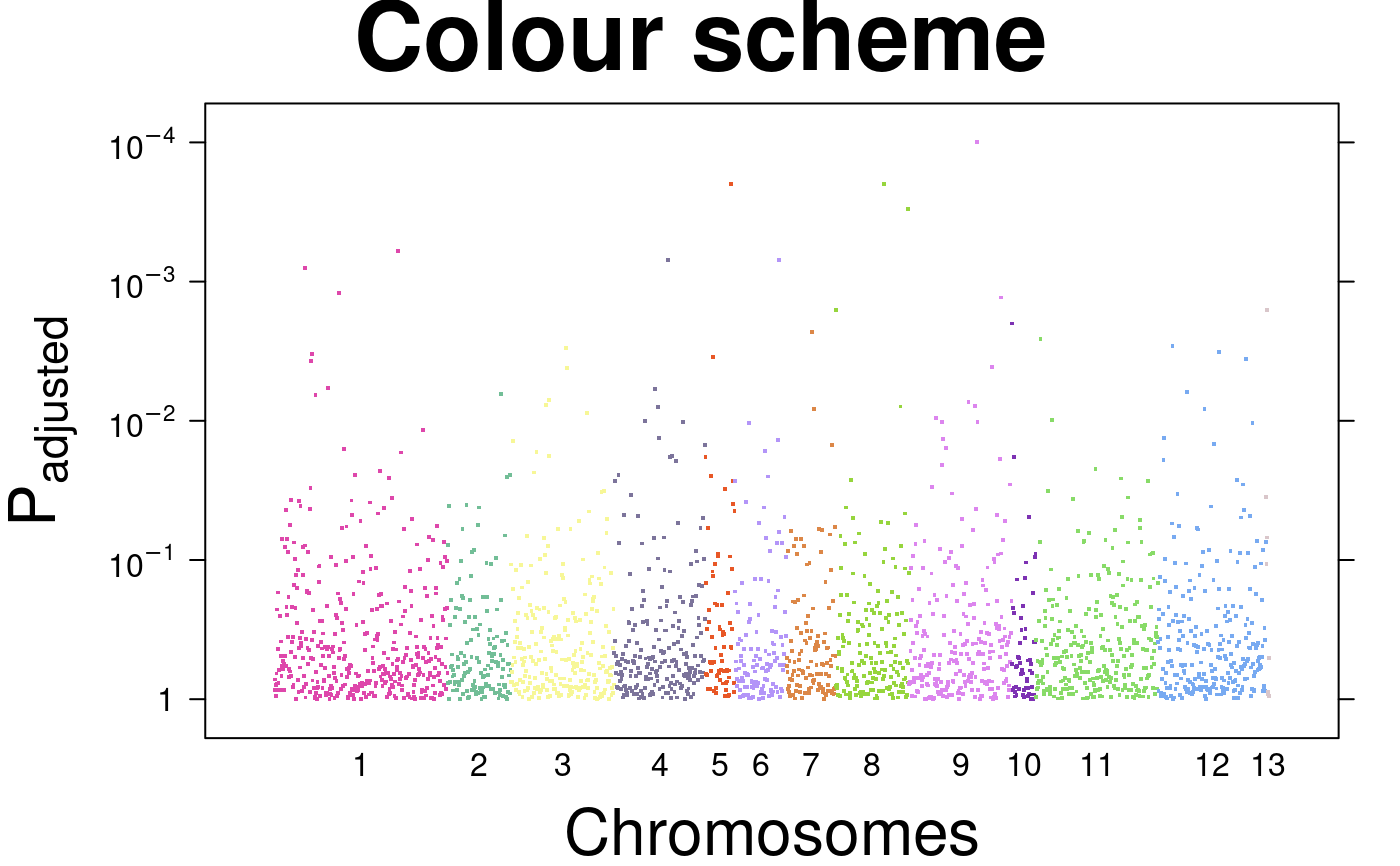 # Plotting Character
create.manhattanplot(
# filename = tempfile(pattern = 'Manhattan_Plotting_Character', fileext = '.tiff'),
formula = -log10(pval) ~ ind,
data = microarray,
main = 'Plotting character',
xlab.label = expression('Chromosomes'),
ylab.label = expression('P'['adjusted']),
xat = chr.tck,
xaxis.lab = c(1:22, 'X', 'Y'),
xaxis.tck = 0,
xaxis.cex = 1,
yaxis.cex = 1,
yat = seq(0,5,1),
yaxis.lab = c(
1,
expression(10^-1),
expression(10^-2),
expression(10^-3),
expression(10^-4)
),
col = chr.colours,
# Change plotting character and size of plotting character
pch = 18,
cex = 0.75,
description = 'Manhattan plot created using BoutrosLab.plotting.general',
resolution = 200
);
# Plotting Character
create.manhattanplot(
# filename = tempfile(pattern = 'Manhattan_Plotting_Character', fileext = '.tiff'),
formula = -log10(pval) ~ ind,
data = microarray,
main = 'Plotting character',
xlab.label = expression('Chromosomes'),
ylab.label = expression('P'['adjusted']),
xat = chr.tck,
xaxis.lab = c(1:22, 'X', 'Y'),
xaxis.tck = 0,
xaxis.cex = 1,
yaxis.cex = 1,
yat = seq(0,5,1),
yaxis.lab = c(
1,
expression(10^-1),
expression(10^-2),
expression(10^-3),
expression(10^-4)
),
col = chr.colours,
# Change plotting character and size of plotting character
pch = 18,
cex = 0.75,
description = 'Manhattan plot created using BoutrosLab.plotting.general',
resolution = 200
);
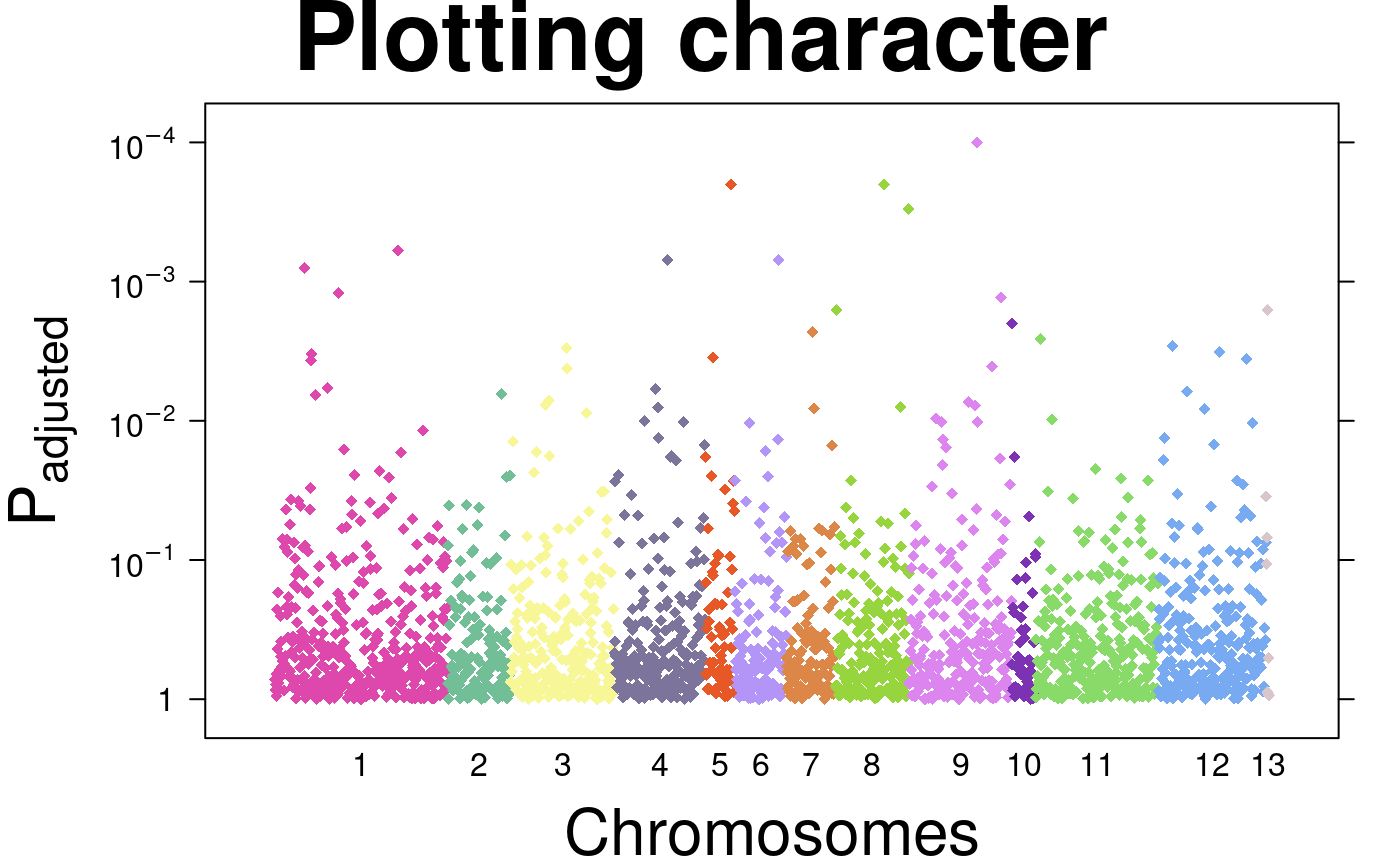 # \donttest{
# Line
create.manhattanplot(
# filename = tempfile(pattern = 'Manhattan_Added_Line', fileext = '.tiff'),
formula = -log10(pval) ~ ind,
data = microarray,
main = 'Line',
xlab.label = expression('Chromosomes'),
ylab.label = expression('P'['adjusted']),
xat = chr.tck,
xaxis.lab = c(1:22, 'X', 'Y'),
xaxis.tck = 0,
xaxis.cex = 1,
yaxis.cex = 1,
yat = seq(0,5,1),
yaxis.lab = c(
1,
expression(10^-1),
expression(10^-2),
expression(10^-3),
expression(10^-4)
),
col = chr.colours,
pch = 18,
cex = 0.75,
# draw horizontal line
abline.h = 2,
abline.lty = 2,
abline.lwd = 1,
abline.col = 'black',
description = 'Manhattan plot created using BoutrosLab.plotting.general',
resolution = 200
);
# \donttest{
# Line
create.manhattanplot(
# filename = tempfile(pattern = 'Manhattan_Added_Line', fileext = '.tiff'),
formula = -log10(pval) ~ ind,
data = microarray,
main = 'Line',
xlab.label = expression('Chromosomes'),
ylab.label = expression('P'['adjusted']),
xat = chr.tck,
xaxis.lab = c(1:22, 'X', 'Y'),
xaxis.tck = 0,
xaxis.cex = 1,
yaxis.cex = 1,
yat = seq(0,5,1),
yaxis.lab = c(
1,
expression(10^-1),
expression(10^-2),
expression(10^-3),
expression(10^-4)
),
col = chr.colours,
pch = 18,
cex = 0.75,
# draw horizontal line
abline.h = 2,
abline.lty = 2,
abline.lwd = 1,
abline.col = 'black',
description = 'Manhattan plot created using BoutrosLab.plotting.general',
resolution = 200
);
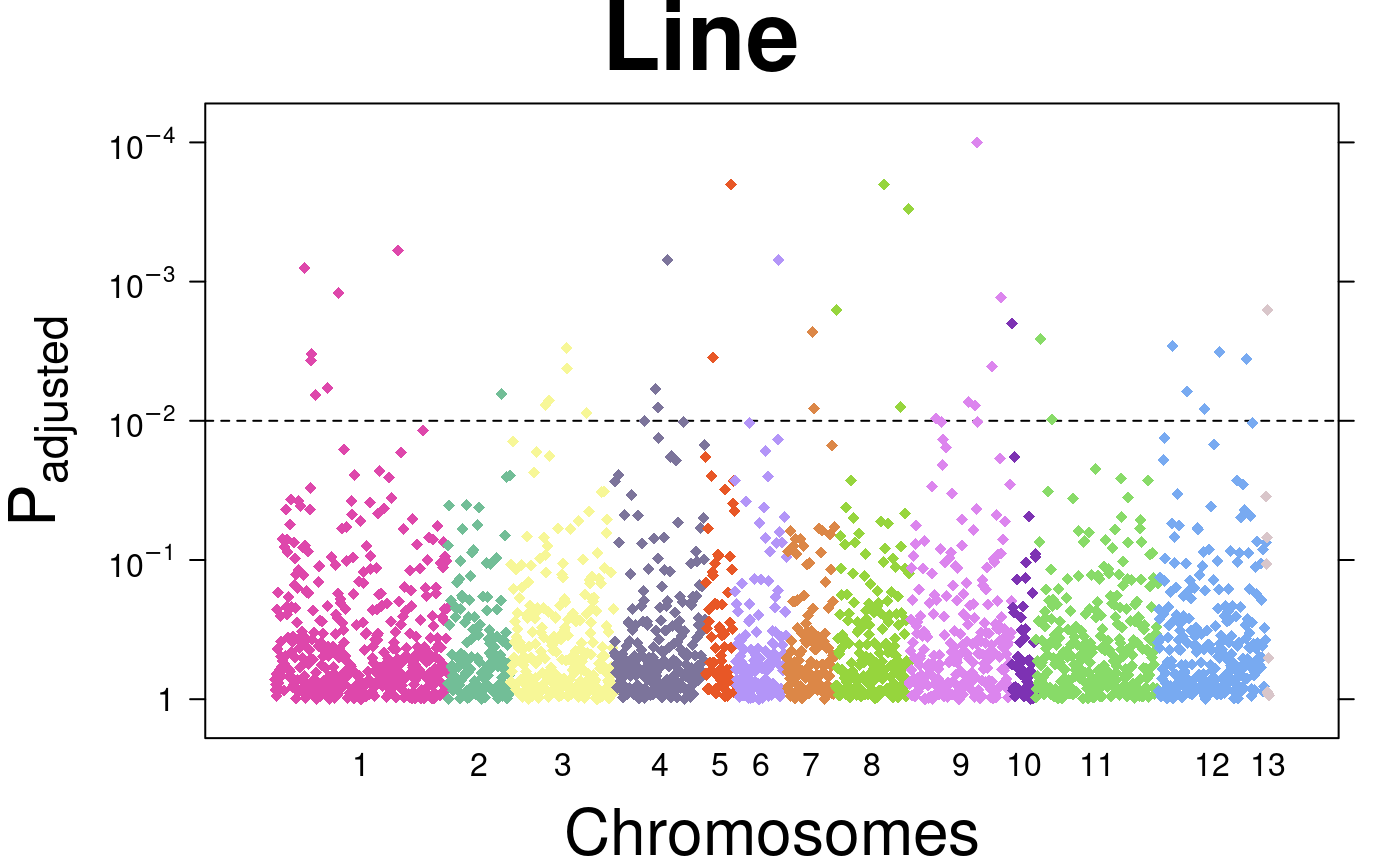 # Background shading
create.manhattanplot(
# filename = tempfile(pattern = 'Manhattan_BG', fileext = '.tiff'),
formula = -log10(pval) ~ ind,
data = microarray,
main = 'Bg rectangles',
xlab.label = expression('Chromosomes'),
ylab.label = expression('P'['adjusted']),
xat = chr.tck,
xaxis.lab = c(1:22, 'X', 'Y'),
xaxis.tck = 0,
xaxis.cex = 1,
yaxis.cex = 1,
yat = seq(0,5,1),
yaxis.lab = c(
1,
expression(10^-1),
expression(10^-2),
expression(10^-3),
expression(10^-4)
),
col = chr.colours,
pch = 18,
cex = 0.75,
abline.h = 2,
abline.lty = 2,
abline.lwd = 1,
abline.col = 'black',
# Adding rectangles
add.rectangle = TRUE,
xleft.rectangle = chr.break[seq(1, length(chr.break) - 1, 2)],
ybottom.rectangle = 0,
xright.rectangle = chr.break[seq(2, length(chr.break) - 1, 2)],
ytop.rectangle = 4.5,
col.rectangle = 'grey',
alpha.rectangle = 0.5,
description = 'Manhattan plot created using BoutrosLab.plotting.general',
resolution = 200
);
#> Warning: longer object length is not a multiple of shorter object length
#> Warning: longer object length is not a multiple of shorter object length
# Background shading
create.manhattanplot(
# filename = tempfile(pattern = 'Manhattan_BG', fileext = '.tiff'),
formula = -log10(pval) ~ ind,
data = microarray,
main = 'Bg rectangles',
xlab.label = expression('Chromosomes'),
ylab.label = expression('P'['adjusted']),
xat = chr.tck,
xaxis.lab = c(1:22, 'X', 'Y'),
xaxis.tck = 0,
xaxis.cex = 1,
yaxis.cex = 1,
yat = seq(0,5,1),
yaxis.lab = c(
1,
expression(10^-1),
expression(10^-2),
expression(10^-3),
expression(10^-4)
),
col = chr.colours,
pch = 18,
cex = 0.75,
abline.h = 2,
abline.lty = 2,
abline.lwd = 1,
abline.col = 'black',
# Adding rectangles
add.rectangle = TRUE,
xleft.rectangle = chr.break[seq(1, length(chr.break) - 1, 2)],
ybottom.rectangle = 0,
xright.rectangle = chr.break[seq(2, length(chr.break) - 1, 2)],
ytop.rectangle = 4.5,
col.rectangle = 'grey',
alpha.rectangle = 0.5,
description = 'Manhattan plot created using BoutrosLab.plotting.general',
resolution = 200
);
#> Warning: longer object length is not a multiple of shorter object length
#> Warning: longer object length is not a multiple of shorter object length
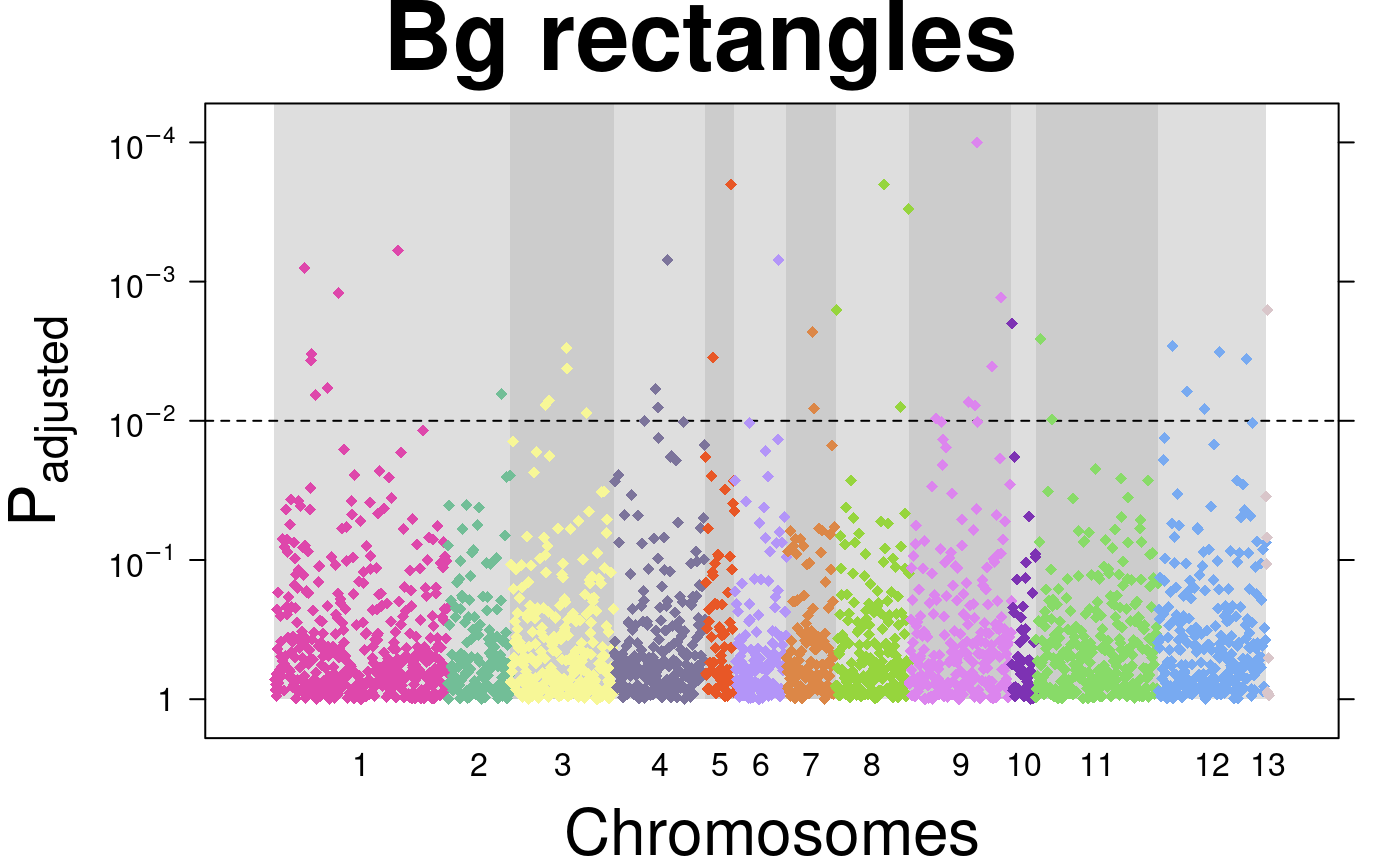 # Nature style
create.manhattanplot(
# filename = tempfile(pattern = 'Manhattan_Nature_style', fileext = '.tiff'),
formula = -log10(pval) ~ ind,
data = microarray,
main = 'Nature style',
xat = chr.tck,
xaxis.lab = c(1:22, 'X', 'Y'),
xaxis.tck = 0,
xaxis.cex = 1,
yaxis.cex = 1,
yat = seq(0,5,1),
yaxis.lab = c(
1,
expression(10^-1),
expression(10^-2),
expression(10^-3),
expression(10^-4)
),
col = chr.colours,
pch = 18,
cex = 0.75,
abline.h = 2,
abline.lty = 2,
abline.lwd = 1,
abline.col = 'black',
# Adding rectangles
add.rectangle = TRUE,
xleft.rectangle = chr.break[seq(1, length(chr.break) - 1, 2)],
ybottom.rectangle = 0,
xright.rectangle = chr.break[seq(2, length(chr.break) - 1, 2)],
ytop.rectangle = 4.5,
col.rectangle = 'grey',
alpha.rectangle = 0.5,
# set style to Nature
style = 'Nature',
# demonstrating how to italicize character variables
ylab.label = expression(paste('italicized ', italic('a'))),
# demonstrating how to create en-dashes
xlab.label = expression(paste('en dashs: 1','\u2013', '10'^'\u2013', ''^3)),
description = 'Manhattan plot created using BoutrosLab.plotting.general',
resolution = 1200
);
#> Warning: Nature also requires italicized single-letter variables and en-dashes
#> for ranges and negatives. See example in documentation for how to do this.
#> Warning: Avoid red-green colour schemes, create TIFF files, do not outline the figure or legend.
#> Warning: longer object length is not a multiple of shorter object length
#> Warning: longer object length is not a multiple of shorter object length
# Nature style
create.manhattanplot(
# filename = tempfile(pattern = 'Manhattan_Nature_style', fileext = '.tiff'),
formula = -log10(pval) ~ ind,
data = microarray,
main = 'Nature style',
xat = chr.tck,
xaxis.lab = c(1:22, 'X', 'Y'),
xaxis.tck = 0,
xaxis.cex = 1,
yaxis.cex = 1,
yat = seq(0,5,1),
yaxis.lab = c(
1,
expression(10^-1),
expression(10^-2),
expression(10^-3),
expression(10^-4)
),
col = chr.colours,
pch = 18,
cex = 0.75,
abline.h = 2,
abline.lty = 2,
abline.lwd = 1,
abline.col = 'black',
# Adding rectangles
add.rectangle = TRUE,
xleft.rectangle = chr.break[seq(1, length(chr.break) - 1, 2)],
ybottom.rectangle = 0,
xright.rectangle = chr.break[seq(2, length(chr.break) - 1, 2)],
ytop.rectangle = 4.5,
col.rectangle = 'grey',
alpha.rectangle = 0.5,
# set style to Nature
style = 'Nature',
# demonstrating how to italicize character variables
ylab.label = expression(paste('italicized ', italic('a'))),
# demonstrating how to create en-dashes
xlab.label = expression(paste('en dashs: 1','\u2013', '10'^'\u2013', ''^3)),
description = 'Manhattan plot created using BoutrosLab.plotting.general',
resolution = 1200
);
#> Warning: Nature also requires italicized single-letter variables and en-dashes
#> for ranges and negatives. See example in documentation for how to do this.
#> Warning: Avoid red-green colour schemes, create TIFF files, do not outline the figure or legend.
#> Warning: longer object length is not a multiple of shorter object length
#> Warning: longer object length is not a multiple of shorter object length
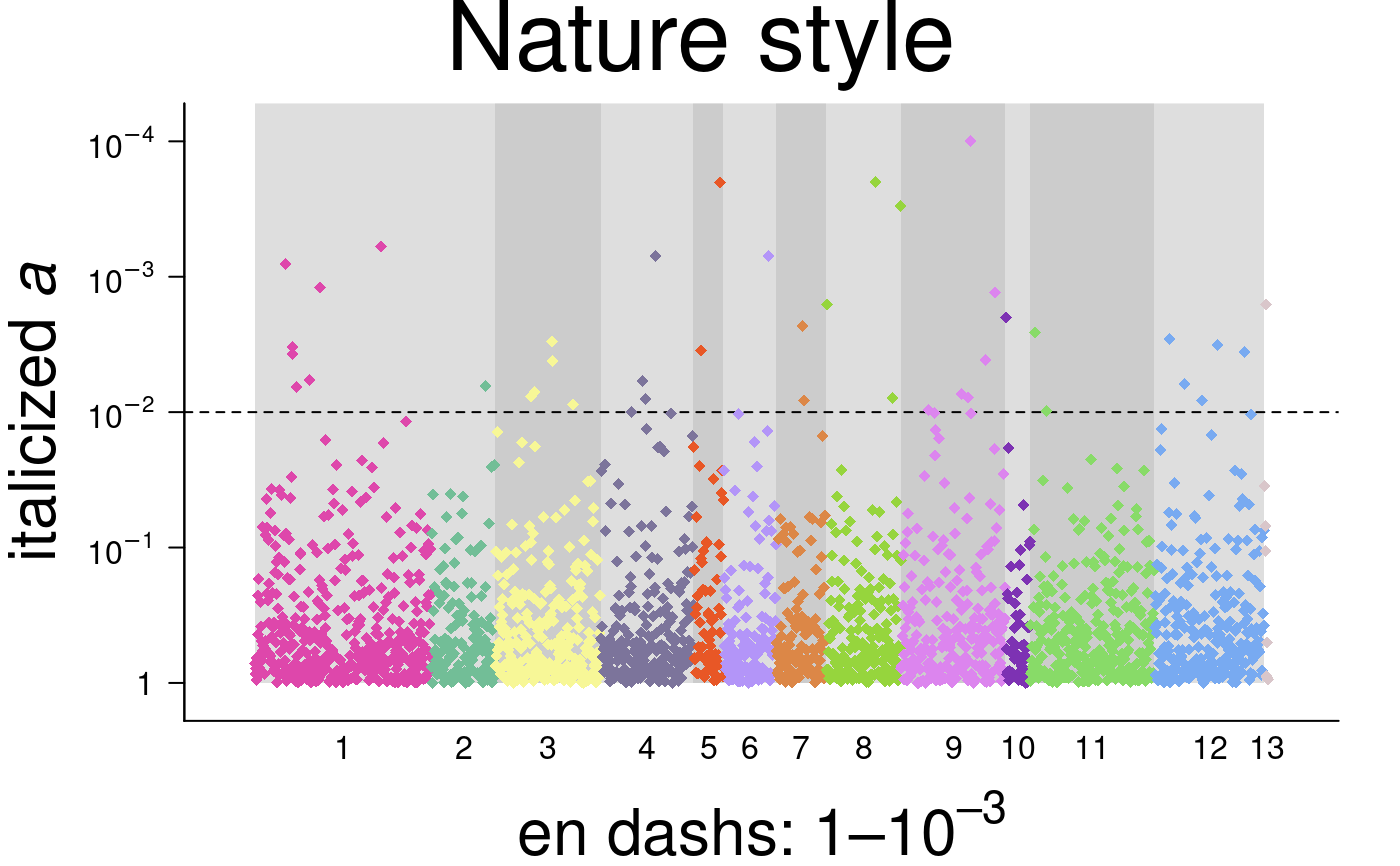 # }
# }